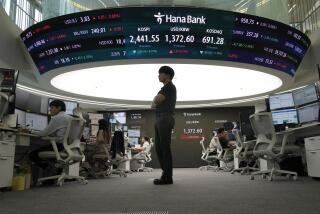INTERNATIONAL BUSINESS : BRIEFING BOOK : South Korea Is Struggling to Keep a Cap on Escalating Salaries
- Share via
ISSUE: South Korean President Kim Young Sam, elected in December after a campaign dominated by economic issues, has prodded private business and labor into agreeing to hold down wage increases in hopes of containing rapidly escalating salaries, which are blamed for Korea’s loss of competitiveness in world trade.
The aim of the government’s effort is to hold wage increases to between 4.7% (for large companies) and 8.9% (for small companies), instead of the double-digit annual increases of the last six years.
To set an example of the sacrifices he wants South Korea’s workers to make, the president has taken to eating noodles at lunch and has ordered a freeze on all government salaries.
BACKGROUND: While authoritarian former generals ran South Korea, wages increased every year between 1963 and 1986 by an average of 7.8%, but they lagged behind annual productivity gains of 12.8%, creating an economy whose competitiveness was based on low wages.
But in 1987, Roh Tae Woo, as a candidate for president, promised to transform the nation into a democracy, including lifting government controls of unions.
After Roh’s election, there was an explosion of pent-up demand from workers.
Manufacturing wages have risen by an average of 18% a year to slightly more than $13,000 annually, outstripping annual productivity gains of 11.3%, according to the Labor Ministry.
In the 1980s, South Korea’s exports grew and the nation racked up trade surpluses. The surplus peaked at $11.4 billion in 1988, but exports began to decline, leading to a deficit in 1990.
The rise in wages without a corresponding increase in productivity undercut South Korea’s ability to maintain a high level of exports.
Additionally, higher wages made Korean exports relatively expensive compared to goods from countries with lower labor costs.
OUTLOOK: Kim’s hope to hold wages to a single-digit increase this year appears doomed.
For the first half of the year, the increases averaged 12.9%--more modest than last year’s 15.7% but still above likely gains in productivity, according to Cho Jeong Ho, director of wages and welfare at the Labor Ministry.
The problem is that most companies are adhering to the labor-management guidelines in form only. Hyundai Motors, for one, granted a 4.9% wage increase, nearly on target. But that rate was only for the basic wage. Including benefits, “the real increase was much, much bigger,” said Kim Noe Myong, Hyundai’s export manager.
Some officials believe the government’s attention to holding down wages is off target.
“Fewer than half of the (labor) disputes this year are focused on wages,” the Labor Ministry’s Cho said.
Instead, unions are seeking better working conditions or pressing such demands as reinstatement of fired union leaders.
Such issues have been central to a number of costly strikes.
Strikes have fallen off dramatically, but Hyundai Motors and a host of other companies in the Hyundai Group were hit by a series of walkouts last summer, including a six-week strike at Hyundai Heavy Industries Co. that settled in August for a 4.7% wage increase. The Hyundai Group strikes have cost an estimated $1.5 billion in production losses.
This year, Korea’s economy is expected to perform at its most sluggish growth rate--about 4%--since 1980, but the reasons, according to the Bank of Korea, don’t include wage increases. Depressed investment, lighter than usual consumption, a psychological blow from sweeping banking reform, and a poor agricultural harvest were cited as the culprits.
STRATEGY: As an “interim strategy” to attack trade deficits, South Korea is nurturing new export markets in Southeast Asia and China. At the same time, it is restructuring the economy so that competitiveness is tied less to low wages. Part of the strategy is to increase productivity with more automation. At the same time, the nation is attempting to focus on making for export higher-value-added products that would be more appealing in quality-conscious markets such as the United States.
South Korea expects a trade surplus this year of about $1.3 billion--two years earlier than the expected turnaround and an indication of the success of the interim strategy.
More to Read
Inside the business of entertainment
The Wide Shot brings you news, analysis and insights on everything from streaming wars to production — and what it all means for the future.
You may occasionally receive promotional content from the Los Angeles Times.










